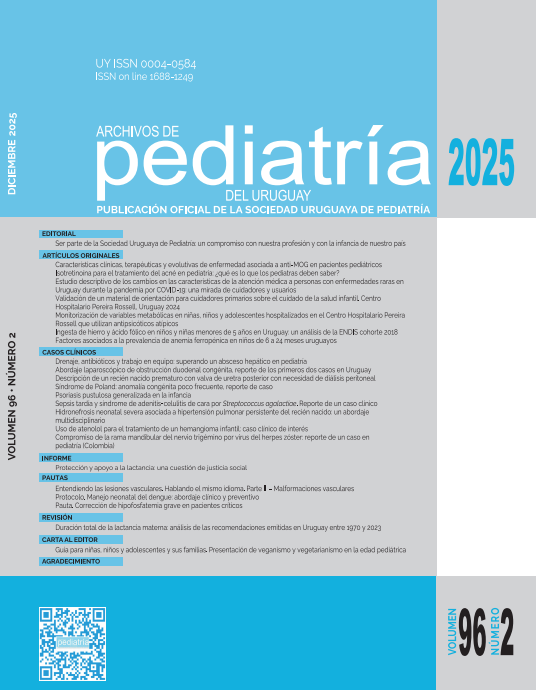Abstract
Introduction: inflammatory Demyelinating Diseases include a broad spectrum of diseases involving the central nervous system. Among them, Myelin Oligodendrocyte Glycoprotein Antibody-Associated Disease (MOGAD) includes syndromes affecting both white and gray matter. MOGAD is identified through anti-MOG antibodies and is treated with immunotherapy, generally presenting a good prognosis in most cases, although some relapsing forms require prolonged treatment.
Objectives: describe the clinical characteristics, treatments administered, and outcomes of a group of children diagnosed with MOGAD, treated at the Pediatric Neurology Service of the Centro Hospitalario Pereira Rossell between January 2022 and June 2024.
Methodology: observational, descriptive, retrospective study based on the clinical records of 14 patients with MOGAD.
Results: we included 14 patients (6 girls and 8 boys) aged 2 to 14 years, with a mean age of 8.7 years. The clinical phenotypes were: acute disseminated encephalomyelitis (n=1), extensive transverse myelitis (n=4), neuromyelitis optica spectrum (n=4), encephalitis (n=4), and monofocal neurological syndrome (n=1). All received intravenous methylprednisolone, which was the only treatment in 9 cases. Two patients additionally required plasmapheresis, one intravenous immunoglobulin (IVIG), and another plasmapheresis, IVIG, and rituximab. Four patients relapsed, three with optic neuritis. Two were treated with azathioprine and two with rituximab. One patient remains under immunosuppression due to the initial severity.
Conclusions: MOGAD is a demyelinating disease with varied clinical phenotypes. It requires a high level of suspicion, with a specific and sensitive biomarker available. The response to treatment is generally good, with few relapses and a low rate of neurological sequelae.
References
Bruijstens A, Lechner C, Flet L, Deiva K, Neuteboom R, Hemingway C, et al. E.U. paediatric MOG consortium consensus: Part 1 - Classification of clinical phenotypes of paediatric myelin oligodendrocyte glycoprotein antibody-associated disorders. Eur J Paediatr Neurol 2020; 29:2-13. doi: 10.1016/j.ejpn.2020.10.006.
Banwell B, Kennedy J, Sadovnick D, Arnold D, Magalhaes S, Wambera K, et al. Incidence of acquired demyelination of the CNS in Canadian children. Neurology 2009; 72(3):232-9. doi: 10.1212/01.wnl.0000339482.84392.bd.
Krupp L, Tardieu M, Amato M, Banwell B, Chitnis T, Dale R, et al. International Pediatric Multiple Sclerosis Study Group criteria for pediatric multiple sclerosis and immune-mediated central nervous system demyelinating disorders: revisions to the 2007 definitions. Mult Scler 2013; 19(10):1261-7. doi: 10.1177/1352458513484547.
Ketelslegers I, Catsman C, Neuteboom R, Boon M, van Dijk K, Eikelenboom M, et al. Incidence of acquired demyelinating syndromes of the CNS in Dutch children: a nationwide study. J Neurol 2012; 259(9):1929-35. doi: 10.1007/s00415-012-6441-6.
Reindl M, Di Pauli F, Rostásy K, Berger T. The spectrum of MOG autoantibody-associated demyelinating diseases. Nat Rev Neurol 2013; 9(8):455-61. doi: 10.1038/nrneurol.2013.118.
Brunner C, Lassmann H, Waehneldt T, Matthieu J, Linington C. Differential ultrastructural localization of myelin basic protein, myelin/oligodendroglial glycoprotein, and 2',3'-cyclic nucleotide 3'-phosphodiesterase in the CNS of adult rats. J Neurochem 1989; 52(1):296-304. doi: 10.1111/j.1471-4159.1989.tb10930.x.
Hemmer B, Archelos J, Hartung H. New concepts in the immunopathogenesis of multiple sclerosis. Nat Rev Neurosci 2002; 3(4):291-301. doi: 10.1038/nrn784.
Jurynczyk M, Messina S, Woodhall M, Raza N, Everett R, Roca A, et al. Clinical presentation and prognosis in MOG-antibody disease: a UK study. Brain 2017; 140(12):3128-38. doi: 10.1093/brain/awx276.
Ramanathan S, Mohammad S, Tantsis E, Nguyen T, Merheb V, Fung V, et al. Clinical course, therapeutic responses and outcomes in relapsing MOG antibody-associated demyelination. J Neurol Neurosurg Psychiatry 2018; 89(2):127-37. doi: 10.1136/jnnp-2017-316880.
Hennes E, Baumann M, Lechner C, Rostásy K. mog spectrum disorders and role of mog-antibodies in clinical practice. Neuropediatrics 2018; 49(1):3-11. doi: 10.1055/s-0037-1604404.
Hacohen Y, Absoud M, Deiva K, Hemingway C, Nytrova P, Woodhall M, et al. Myelin oligodendrocyte glycoprotein antibodies are associated with a non-MS course in children. Neurol Neuroimmunol Neuroinflamm 2015; 2(2):e81. doi: 10.1212/NXI.0000000000000081.
Sun X, Liu M, Luo X, Yuan F, Wang C, Wang S, et al. Clinical characteristics and prognosis of pediatric myelin oligodendrocyte glycoprotein antibody-associated diseases in China. BMC Pediatr 2022; 22(1):666. doi: 10.1186/s12887-022-03679-3.
Olivé G, Armangué T. Primer episodio desmielinizante y enfermedad asociada a anticuerpos contra MOG. En: Caraballo R, Campistol J, Gonzalez G, eds. Neuropediatría: fundamentos prácticos. Buenos Aires: Panamericana, 2023:1075-87.
Armangue T, Capobianco M, de Chalus A, Laetitia G, Deiva K. E.U. paediatric MOG consortium consensus: Part 3 - Biomarkers of paediatric myelin oligodendrocyte glycoprotein antibody-associated disorders. Eur J Paediatr Neurol 2020; 29:22-31. doi: 10.1016/j.ejpn.2020.11.001.
Marchionatti A, Hansel G, Avila G, Sato D. Detection of MOG-IgG in clinical samples by live cell-based assays: performance of immunofluorescence microscopy and flow cytometry. Front Immunol 2021; 12:642272. doi: 10.3389/fimmu.2021.642272.
Baumann M, Bartels F, Finke C, Adamsbaum C, Hacohen Y, Rostásy K. E.U. paediatric MOG consortium consensus: Part 2 - Neuroimaging features of paediatric myelin oligodendrocyte glycoprotein antibody-associated disorders. Eur J Paediatr Neurol 2020; 29:14-21. doi: 10.1016/j.ejpn.2020.10.002.
Bruijstens A, Wendel E, Lechner C, Bartels F, Finke C, Breu M, et al. E.U. paediatric MOG consortium consensus: Part 5 - Treatment of paediatric myelin oligodendrocyte glycoprotein antibody-associated disorders. Eur J Paediatr Neurol 2020; 29:41-53. doi: 10.1016/j.ejpn.2020.10.005.
Jarius S, Ruprecht K, Kleiter I, Borisow N, Asgari N, Pitarokoili K, et al. MOG-IgG in NMO and related disorders: a multicenter study of 50 patients. Part 2: Epidemiology, clinical presentation, radiological and laboratory features, treatment responses, and long-term outcome. J Neuroinflammation 2016; 13(1):280. doi: 10.1186/s12974-016-0718-0.
Armangue T, Olivé G, Martínez E, Sepulveda M, Ruiz R, Muñoz M, et al. Associations of paediatric demyelinating and encephalitic syndromes with myelin oligodendrocyte glycoprotein antibodies: a multicentre observational study. Lancet Neurol 2020; 19(3):234-46. doi: 10.1016/S1474-4422(19)30488-0.
Bruijstens A, Breu M, Wendel E, Wassmer E, Lim M, Neuteboom R, et al. E.U. paediatric MOG consortium consensus: Part 4 - Outcome of paediatric myelin oligodendrocyte glycoprotein antibody-associated disorders. Eur J Paediatr Neurol 2020; 29:32-40. doi: 10.1016/j.ejpn.2020.10.007.
Banwell B, Bennett J, Marignier R, Kim H, Brilot F, Flanagan E, et al. Diagnosis of myelin oligodendrocyte glycoprotein antibody-associated disease: International MOGAD Panel proposed criteria. Lancet Neurol 2023; 22(3):268-82. doi: 10.1016/S1474-4422(22)00431-8.

This work is licensed under a Creative Commons Attribution 4.0 International License.
Copyright (c) 2025 Archives of Pediatrics of Uruguay


